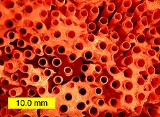
Organ pipe coral
Encyclopedia
The Organ pipe coral is an alcyonaria
n coral
native to the waters of the Indian Ocean
and the central and western regions of the Pacific Ocean
. It is the only known species of the genus Tubipora. This species is a soft coral but with a unique, hard skeleton of calcium carbonate
that contains many organ pipe-like tubes. On each tube is a series of polyp
s which each have eight feather-like tentacles. These tentacles are usually extended during the day, but will swiftly withdraw with any sort of disturbance. The skeleton is a bright red color, but is typically obscured by the numerous polyps, which are green or gray in color. In size, colonies can reach up to a meter across, while the individual polyps are typically less than 3 mm wide and a few mm long. They are restricted to shallow waters and tend to live in sheltered areas. They eat plankton. They are close relatives to other soft coral and sea fans.
Alcyonaria
Octocorallia is a subclass of Anthozoa comprising ~3,000 species of water-based organisms formed of colonial polyps with 8-fold symmetry. It includes the blue coral, soft corals, sea pens, and gorgonians within three orders: Alcyonacea, Helioporacea, and Pennatulacea...
n coral
Coral
Corals are marine animals in class Anthozoa of phylum Cnidaria typically living in compact colonies of many identical individual "polyps". The group includes the important reef builders that inhabit tropical oceans and secrete calcium carbonate to form a hard skeleton.A coral "head" is a colony of...
native to the waters of the Indian Ocean
Indian Ocean
The Indian Ocean is the third largest of the world's oceanic divisions, covering approximately 20% of the water on the Earth's surface. It is bounded on the north by the Indian Subcontinent and Arabian Peninsula ; on the west by eastern Africa; on the east by Indochina, the Sunda Islands, and...
and the central and western regions of the Pacific Ocean
Pacific Ocean
The Pacific Ocean is the largest of the Earth's oceanic divisions. It extends from the Arctic in the north to the Southern Ocean in the south, bounded by Asia and Australia in the west, and the Americas in the east.At 165.2 million square kilometres in area, this largest division of the World...
. It is the only known species of the genus Tubipora. This species is a soft coral but with a unique, hard skeleton of calcium carbonate
Calcium carbonate
Calcium carbonate is a chemical compound with the formula CaCO3. It is a common substance found in rocks in all parts of the world, and is the main component of shells of marine organisms, snails, coal balls, pearls, and eggshells. Calcium carbonate is the active ingredient in agricultural lime,...
that contains many organ pipe-like tubes. On each tube is a series of polyp
Polyp
A polyp in zoology is one of two forms found in the phylum Cnidaria, the other being the medusa. Polyps are approximately cylindrical in shape and elongated at the axis of the body...
s which each have eight feather-like tentacles. These tentacles are usually extended during the day, but will swiftly withdraw with any sort of disturbance. The skeleton is a bright red color, but is typically obscured by the numerous polyps, which are green or gray in color. In size, colonies can reach up to a meter across, while the individual polyps are typically less than 3 mm wide and a few mm long. They are restricted to shallow waters and tend to live in sheltered areas. They eat plankton. They are close relatives to other soft coral and sea fans.

